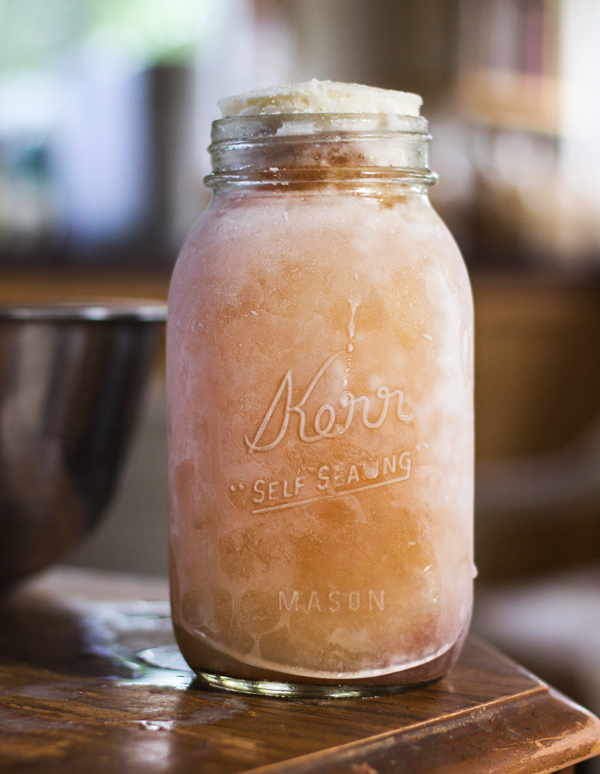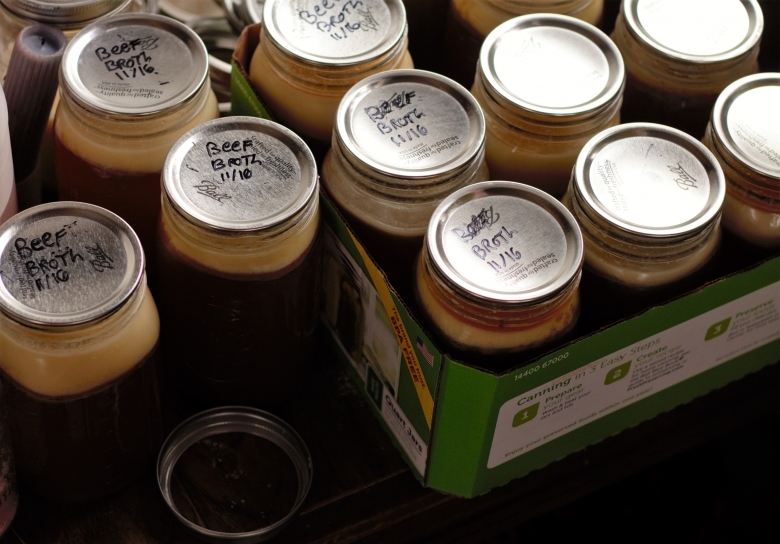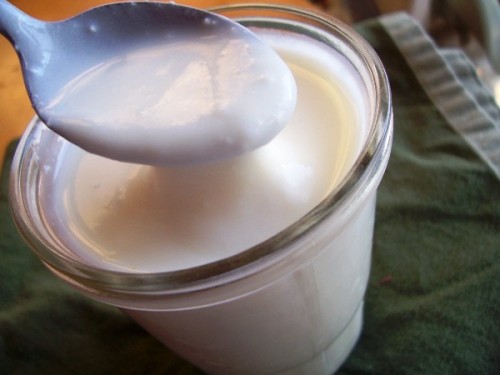Making, Freezing, and Canning Beef Bone Broth

I have been making a lot of beef broth the last few months between a bull we brought in and a few extra boxes of bones we’ve since gathered from that same butcher. Beef broth is no joke with its thick layer of fat on top of each pot and its necessitating a hacksaw to get the bones into the pots. But it is deep nourishment and cheap as well so I am grateful.
So every week I have been about the business of making plenty of broth. Here’s how.
Making Beef Broth
We bring home large boxes full of bones from the butcher. After cutting the larger ones with a hacksaw, we generally fill three large stock pots. I then proceed as follows:
- Cover the bones with filtered water and a splash of apple cider vinegar and simmer for 12-18 hours.
- Turn off heat and let pots rest for an additional 8-12 hours.
- Skim off the fat and set aside. Remove bones and pour into quart jars.
- Eat straight away or preserve either by canning or stashing in our solar freezer (or our neighbor’s).

Preserving Broth: Freezing
Do you see the crack at the bottom of the jar above? Also, notice the fat pushing out from the jar rim. This batch of broth I had jarred thinking they were making their way into a refrigerator. I later found out we would be storing them in our small solar freezer but didn’t change the volume in the jars to compensate. Big mistake!
Liquids expand when they are frozen and so the most important thing you can do when freezing broth is to fill your jars only about 80% full. This should give them room to expand and you will be far less likely to lose jars and broth in the process.
We eat through our broth in a week as we can’t store it too long with our solar freezer. We have also been using the frozen broth as “ice” in a cooler we keep a few grocery store items in. So every morning we move two jars from the cooler into the kitchen for cooking and then two jars go from the solar freezer and into the cooler to thaw and act as ice.

Preserving Broth: Canning
The main method I use for preserving broth for the long term is canning. This gives us long term storage without having to use our solar freezer which isn’t always reliable. After all of the broth is made and strained into jars I follow these canning guidelines from the USDA:
With all of this broth going in and out of pots, we have been consuming at least two quarts per day or 3-4 gallons per week. If you aren’t familiar with the benefits of bone broth and the minerals, collagen, gelatin, and easily assimilated amino acids it contains, this article has a lot of great information.


Thank you for the information. I am trying to make my family consume bone broth.
How long does bone broth last if only refrigerated?? I know soup lasts for 3-4 weeks, or more, in the fridge using broth.
Kim – In my experience, broth can last for weeks in the refrigerator – and maybe even months – if there is a layer of fat atop the broth. That fat protects the broth underneath from oxygen and therefore spoilage. Even without that fat cap, though, a couple of weeks is reasonable.
I do make bone broth for my family. Following your pointers of course! 🙂
Our main source is chicken broth from the chickens we raise on our land. The beef bones from our butcher that I’ve purchased a few times aren’t much cheaper than the actual meat. Which is crazy. I think people are waking up to the benefits of bone broth.
Question for you, what do you do with the beef fat you set aside?
P.S. I’m excited for your book to be released. 🙂
CShines – Wow – the bones are as much as the meat? That is crazy!
Once the fat is skimmed from the broth you can render it like tallow. If I’m not sure that the animal is grass-fed, however, I more hesitant to eat a lot of it. With our chickens and any local longhorns, though, we render it and cook with it.
And thanks for your interest in my book!
I am wondering if I am simmering my broth for too long? I use grassfed knuckles.
I let it simmer for 24 hours for round one. Then I remove the broth and add water again and let simmer for another 36 hours for round 2. I use 1 part bones, 2 parts water. So double the weight of the bones and that’s how much water I use.
This seemed to me the most frugal way of making bone broth. I know the second batch isn’t as good, but it felt like a waste to toss. After 24 hours, the bones still look like there is gelatin and minerals in there. There is usually some marrow too.
My husband and I are vegetarians, so I freeze and/or can a lot of vegetable broth. I use the various broth to either add more flavor or as a thickening agent. Potato broth will thicken up just about any sauce without adding unwanted flavor. Because I save the ends of all my vegetables such as celery, carrots, onions, etc., and also the stems of mushrooms, once or twice a month, I cook them down to make a really nice vegetable broth that I can add to soups or various beans. I have made chicken and other meat broths so that I can use them for my grandkids when they come to stay with us. I have also cooked fish heads ( sounds gross) down to make some very tasty fish broth. Fish broth is excellent to flavor rice or noodles.